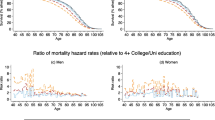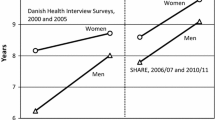Summary
Objectives: Health status of a population can be evaluated by health expectancy expressed as average lifetime in various states of health. The purpose of the study was to compare health expectancy in population groups at high, medium and low educational levels.
Methods: Health interview data were combined with life table figures using Sullivan’s method.
Results: Life expectancy was 4.3 years longer for 30-year-old men with a high educational level than for those with a low level. At age 30, the proportion of expected lifetime in self-rated good health was 67.7%, 76.1% and 82.3% for men with a low, medium and high educational level, respectively. Among women, life expectancy differed by 2.7 years between low and high educational level, and the proportion of expected lifetime in self-rated good health was 62.5% at the low and 80.5% at the high educational level.
Conclusions: Educational level and life expectancy are clearly related. The social gradient in terms of health expectancy is even greater than that in terms of life expectancy.
Similar content being viewed by others
Author information
Authors and Affiliations
Corresponding author
Rights and permissions
About this article
Cite this article
Brønnum-Hansen, H., Andersen, O., Kjøller, M. et al. Social gradient in life expectancy and health expectancy in Denmark. Soz.-Präventivmed. 49, 36–41 (2004). https://doi.org/10.1007/s00038-003-3003-9
Issue Date:
DOI: https://doi.org/10.1007/s00038-003-3003-9




